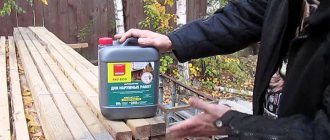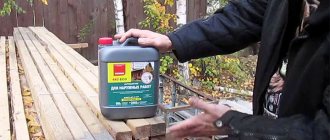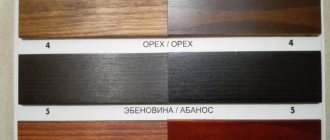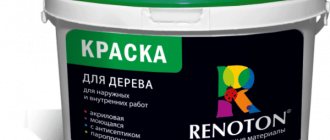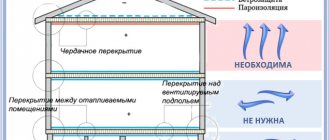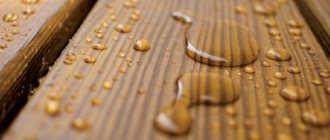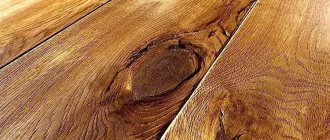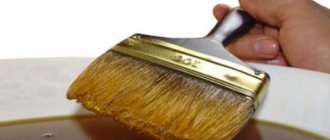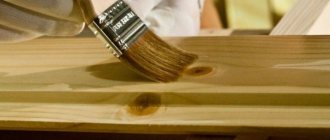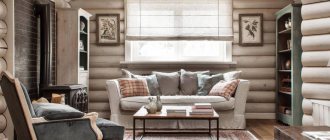Wood as a material will never lose its relevance. But to maintain its beauty and durability, the surface must be periodically subjected to protective treatment.
In outdoor conditions, impregnation for outdoor use is used for this purpose. Thanks to it, the tree becomes resistant to bad weather, insects, and fire.
The main thing is to choose the impregnation that suits your design and is suitable for its purpose.
Why impregnate wood?
The material is popular in construction due to the following advantages:
- environmental friendliness;
- hygroscopicity;
- heat capacity;
- sound insulation;
- aesthetics (even without additional finishing);
- ease of processing and installation;
- affordable price.
However, a wooden structure that is constantly located on the street is destroyed over time under the influence of:
- ultraviolet rays;
- high humidity;
- fungus, mold;
- insects, bark beetles;
- precipitation;
- dust, dirt;
- sudden changes in temperature;
- damage;
- fire.
To prevent spoilage, an impregnation was developed.
It is needed to extend the service life of the material by forming a protective layer on the surface or penetrating deep into the structure.
The drugs are produced in a narrowly targeted manner, when some resist moisture, others – fungus (antiseptics), others – fire (fire retardants), there are decorative ones and more. Complex action impregnations are also available. They are more expensive, but more effective.
It is recommended to work with the product at a temperature of +10 degrees. It will absorb evenly and dry quickly.
In addition, impregnation can be an excellent base for painting. The paint applies well, giving the wood the desired color.
Base type
Impregnations are also distinguished by the type of base. They are:
. These products are inexpensive and have good water-repellent properties. Their advantage is environmental friendliness. The compositions dry quickly and do not emit an unpleasant odor. Such impregnations are recommended for slightly damp wood, into which solvent-based products will not penetrate. One of the disadvantages is the inability to process wood at subzero temperatures. Acrylic impregnations are not recommended for old, dry wood. Under the influence of such compounds, the material may swell and crack.
Water based (acrylic)- Organic based . This type of water repellent is more often used outside buildings. They reliably protect the tree from the negative influence of the environment, penetrate inside faster and deeper. Their disadvantage is toxicity, which persists until the liquid dries completely. Therefore, it is better to use organic impregnations outdoors. If they are intended for interior work, then be sure to ventilate the room well and use personal protective equipment during processing. Organic water repellents are used for both planed and unplaned logs.
- On a combined basis . These products have the advantages of both products at once, since they contain both an organic and a water-dispersed component. The first provides deep, the second - superficial protection.
What you need to know about wood species when choosing impregnation
Depending on the type, trees have different degrees of resistance to biodestruction:
- The weakest. This includes linden, alder, and aspen.
- Weak resistance. Solid elm, maple, birch and beech sapwood.
- Medium resistant. These include fir, larch, and spruce.
- Sustainable. Ash, pine, solid oak.
Based on absorbency, rocks are divided into 3 categories:
- Difficult to impregnate. Ash, solid oak and beech, spruce.
- Average. Linden, alder, aspen, solid pine.
- Lungs. Beech, birch, pine sapwood.
It is important to note that when choosing raw materials for construction outside, the key factor remains the resistance of the rock to destruction, so you need to choose the most resistant ones.
Characteristics of impregnation using the example of “Galamix”
An example of a decorative impregnation with protective properties is a composition such as “Galamix-57”. Impregnation refers to water-dispersion compositions based on acrylic.
The main advantages of Galamix-57:
- Complete environmental safety of the product, since its production does not use toxins, which also emit unpleasant odors.
- Harmless to the human body, which means it can be used not only outside the building, but also for interior work.
- The components of the product ensure that the coating is resistant to aggressive environmental factors for a decade.
- Both colorless and colored formulations are offered.
Material consumption
"Galamix" is characterized by economical consumption: from 100 to 120 grams per square meter. To calculate the required amount of material, you need to multiply the indicated consumption by the total area of the room. In this case, it is recommended to take a reserve of 10-15% of the calculated one.
Color palette of Galamix protective and decorative primer impregnation
The reserve is required based on several factors, including:
- method of application (if a spray bottle is used, the consumption will be higher);
- technological costs;
- level of porosity of the material.
Surface preparation
Treatment with Galamix impregnation is not very difficult, however, in order to ensure the stability and service life declared by the manufacturer, it is necessary to fully comply with the technological requirements. First of all, we are talking about preparatory activities.
Before impregnating the surface, you must perform the following steps:
- Remove dust, debris and other contaminants from the surface.
- If there are old coating layers, they must be removed.
- You also need to remove darkened areas, since if this is not done, then in the case of transparent impregnation, the darkening will remain visible.
- Remove all drips and stains.
Surface grinding also improves the adhesive properties of the material. The level of adhesion expresses the ability of one material to adhere to another. For grinding, a grinding surface with a 120-micron grit is considered optimal. It is recommended to carry out grinding work using a grinder.
Application of impregnation
Impregnation of wood can be carried out using various tools. It is more convenient to use a brush to treat hard-to-reach places and joints. The roller is more suitable for large surfaces - with one movement of this tool you can process a large area. The sprayer is recommended for use over large areas (for example, when impregnating the facade of a building). Using a sprayer allows you to obtain maximum coating quality, as well as uniform distribution of the material.
When applying impregnation, it is recommended to adhere to the following rules:
- The coating is applied parallel to the wood fibers.
- If the wood is loose, its fibers may rise when moistened. To avoid this, it is necessary to grind after drying the material. Grinding is carried out using fine-grained sandpaper (grain size - from 240 to 320 micrometers). After sanding, you need to apply another layer of impregnating composition. Sometimes a third layer may be needed.
- The approximate time for drying the surface after applying each layer is from an hour to two. The surface finally dries about a day after treatment.
Classification of impregnations for external use by purpose
According to this parameter, funds are divided into several types. Let's look at the features of each of them in more detail.
Anti-darkening
A change in the color coating of raw materials is caused by infection with a fungus. This most often happens when wood is stored outdoors for a long time or in constant contact with the ground.
It is important to understand that budget protective impregnations have a limited service life - from 3 to 6 months. More expensive formulations continue to operate after 1–2 years.
The drug must be difficult to wash out or cannot be washed out with water. A striking example is the domestic impregnation brand “Senezh”.
Material already infected with fungus must first be bleached, that is, the cause of infection - fungus or mold - must be eliminated.
For treatment in outdoor conditions, it is allowed to use products containing chlorine. But a significant disadvantage of such compositions is that the impregnation not only burns out harmful microorganisms, but also destroys the wood structure.
Preparations with active oxygen have proven to be much more effective. They destroy fungus without harming the material and do not emit harmful substances.
From moisture and rotting
These are solutions with water-repellent properties. Penetrate deep into the structure. Prevents deformation and rotting of raw materials under the influence of moisture.
Their advantage is that after applying the composition the wood continues to breathe.
The service life of the protective layer is 1-3 years. After its expiration, it is recommended to recoat the material.
High quality impregnation will prevent the material from cracking as it dries. This is especially necessary on the end parts of log houses.
In addition, look for the presence of ultraviolet filters in the composition. Their absence will lead to a reduction in the effect of the product, and the treated surface will begin to darken.
For load-bearing structures
These include:
- rafter systems;
- beams, partitions;
- ceilings;
- walls;
- base;
- basements.
Photo: treatment of the rafter system with a spray bottle.
To reliably protect such elements, the preparation must have the following properties:
- antiseptic;
- fungicidal;
- do not wash off with water;
- increase fire resistance.
They are often colorless, water-based liquids.
The disadvantage of inexpensive impregnations is that they paint the surface a greenish tint. Expensive preparations do not change the shade of wood.
When using indoors, it is important to pay attention to the composition so that it does not contain toxic substances.
Decorative
Compared to others, the purpose of these stains is to add beauty to structures and products. With their help, it will be possible to perform high-quality imitation of noble breeds.
Most acrylic-based products are environmentally friendly. They make the surface elastic, waterproof, add shine, protect the surface from ultraviolet rays, and at the same time act as an antiseptic. They have a wide range of colors.
Frost-resistant
It is recommended to purchase for external wood processing in the northern regions of the country. Withstands air temperatures down to –40 degrees.
Can be applied in the cold without loss of working properties. They tolerate repeated freezing and thawing normally.
Sun protection
They also act as antiseptics. They contain a filter against ultraviolet rays, which serves as reliable protection for the tree. Bright colors do not fade in the sun or fade over time. The surface does not crack due to temperature changes.
Article: how to build a pergola from wood
Fire retardants
This is the name given to the preparations that make the raw material highly flammable. Prevents combustion in case of fire.
The most effective products are those that combine fire and bioprotection. Penetrate deeply into the structure or form a film. They may change the color of the coating, but not the texture of the wood.
When purchasing fire retardants, check for quality certificates and fire safety reports.
Protective compounds against pests
The best wood protection products with insecticidal properties will help prevent the appearance of uninvited guests: beetles, termites, ants, etc., which often carry fungal spores and also make passages in the bark. For example, wood-boring beetles are capable of gnawing tunnels up to 40 m long in a tree. Moreover, the damage can be so significant that the boards lose strength and collapse from the inside even with a small number of entrance holes. There are often cases when, for the construction of a house, lumber is purchased that is made from a tree already infested with beetles, the presence of which only becomes evident over time.
Meffert
Woodmaster Anti-bug, biocidal composition (“Rogneda”) (pack of 5 l - 299 RUR)
"Rogneda"
Anti-beetle for wood Propitex (Meffert) (11 kg pack - 423 RUR)
Neomid
StopBeetle Neomid 100 for the destruction of wood-boring insects, the concentrate is diluted 1:4 (pack of 5 l - 1,300 rubles).
Most protective products against wood-boring beetles and other insects are designed to not only prevent their appearance, but also destroy them at all stages of development. In the latter case, the insecticidal solution is usually applied in a greater number of layers than during preventive treatment, and concentrated products are diluted with less water.
It is more difficult to get rid of beetles and their larvae in heavily damaged wood: the drug is sequentially injected into the entrance and exit holes using the injecting method, and after 2 weeks the procedure is repeated. The cost of 5 liters of Anti-bug product is from 299 rubles.
Some modern antiseptics can not only prevent damage to wood, but even treat material that has begun to deteriorate.
Famous manufacturers
Below is a list of manufacturing companies whose products are in greatest demand.
Belinka
Country of origin: Slovenia.
Engaged in the production of impregnations for the protection and decoration of wood. This:
- transparent antiseptics;
- penetrating primers;
- azure multilayer impregnation with the addition of wax;
- azure decorative impregnations;
- paints.
Belinka has official representative offices throughout Russia.
Aquatex
A Russian company that produces several types of combined impregnation compositions:
- “Aquatex Extra” - based on wax, oil;
- “Aquatex primer antiseptic” is a non-washable antiseptic;
- "Aquatex" - decorative with bioprotection and others.
Each contains an ultraviolet filter.
Aquatex does not produce products with biopyrene protection.
Tikkurila
The Finnish concern produces many series of paint and varnish products. Products with antiseptic protection, against insects, ultraviolet radiation. They have an environmentally friendly composition. Some antiseptics can be tinted.
Senezh
Russian trademark.
Specialization - production of impregnations for processing wood and decking boards.
The list of products includes:
- biopyrenes;
- preservative solutions;
- antiseptics;
- decorative;
- protective compounds.
There are tinted solutions. The price is affordable.
NEOMID
Russian manufacturing company.
The products are considered one of the best on our market for protecting wood and decking boards from fire and moisture.
On average, antiseptic protection lasts 10 years, and against fire – 7 years.
To control the quality of processing, a tinting pigment is included.
Can be used in residential buildings, bathhouses, gazebos, summer kitchens.
Alkyd impregnations
Deep penetration alkyd impregnations have four functions, protecting against:
- exposure to moisture;
- vital activity of insects;
- fire;
- mold.
The effectiveness of the solution for enclosed spaces is less than 5 years, and with an additional moisture-proof coating – up to 15 years. The consumption of such impregnations is 75-125 ml/m2. Drying time at a temperature of +240C and 60% humidity is 24 hours. Work is carried out at +5-280C.
The solution contains an alkyd resin, which forms a film, biocidal additives that prevent rotting and mold development, as well as dye pigments. White spirit is used as a solvent.
The appearance of wood treated with impregnation is glossy. Alkyd compositions do not change their integrity when exposed to different temperatures, are resistant to moisture, and can simultaneously serve as a primer, protective impregnation and final varnish coating. Colorless solutions give wood shine, with the addition of pigments to match elite wood species - create a presentable look for the room.
To ensure that compositions based on alkyd resins with a coloring element apply evenly, it is better to use a spray bottle and monitor the dryness of the wood (preferably 95-100%). Also, unevenness can occur if the impregnation is not stirred every 4 minutes or the wood has a very heterogeneous structure.
Tips for choosing
When purchasing, we recommend paying attention to the following points:
- Purpose and place of use. Indoors, it is worth taking environmentally friendly water-based formulations with natural oils. They are produced in the form of a concentrate. There are no special restrictions for outdoor work.
- Availability of quality certificates. Without them, the likelihood of purchasing an effective product is minimal.
- Determine the reason for processing. There are narrowly targeted impregnations on sale that protect only from moisture, insects or fire. The optimal purchase would be a complex drug that combines several properties at once.
- If you want your product to look beautiful, take time to choose the color. Check to see if the product can be tinted.
- Take the drug with a reserve, since concentrates from different batches may differ in tone.
- You should not buy impregnation in the markets. The conditions for storing and transporting goods there are practically not observed. There is a high risk of purchasing a fake.
- Study the instructions for use, namely the service life of the coating. Most products retain their properties for no more than 3-5 years. Inflated figures are a marketing ploy.
- Don't forget about application methods. There are impregnations that are used only by soaking the wood.
- Don't forget to wear a respirator while working.
For outdoor use, it is recommended to use universal, complex action products that simultaneously resist bad weather, insects and fire.
Impregnations: types and features
Wood impregnations come in several types:
- Those for which a water base is used. They are odorless, dry quickly, harmless and non-toxic. There is no need to pre-dry the surface on which they are applied. However, such impregnations penetrate only to a small depth, protect superficially, and are not suitable for wood, which often comes into contact with moisture. They are used to treat residential premises, outbuildings, and individual elements of structures.
- Impregnations for wood for outdoor use, of organic origin. They are distinguished by deep penetration into the processed material and a persistent odor that evaporates over time. Before applying them, you need to prepare the wooden surface. Used in structures that come into contact with water (cellar, basement).
- Alkyd impregnations. Pinotex products have proven themselves well. Pinotex wood impregnation for exterior use penetrates well into the thickness of the surface and does not require mandatory treatment of the wood before application. Used for decorative purposes, has a wide choice of colors.
- Impregnations with wax, which are sold with the addition of beeswax, oils, and inorganic substances. Waxing gives the wood a velvety tone and serves as moisture-resistant protection. Different colors are used for different types of wood. The technique of applying several layers of different colors is interesting. Such wax impregnations come in both paste and liquid form. Before applying them, it is necessary to thoroughly clean the surface, remove any remaining varnish and other substances. Wax impregnations are used not only for large wooden structures, but also for waxing furniture and interior items.
Painting features
The quality and durability of a painted surface depends not only on the choice of coating, but also on the quality of its application. Therefore, below we will consider how to properly paint wood with waterproof paintwork.
So, the instructions look like this:
- You need to start work by preparing the surface - the wood must be cleaned of the old coating, putty and sanded if necessary.
- Then the paint is prepared - shaken thoroughly; if the composition is tinted, then the required amount of color is added to it to obtain one or another shade.
- Next, apply the composition with your own hands onto the wooden surface in a thin, even layer. To do this, you can use a sprayer, paint roller or brush.
- After the first layer has hardened, the coating is applied again. In most cases, two coats are sufficient to achieve an even color and a smooth surface.
Advice! Before painting, the wood can be coated with an antiseptic primer, which will improve the adhesion of the paintwork and also protect the wood from the effects of microorganisms, mold, etc.
This completes the painting process.
We do not allow parasites
Antiseptic protection is necessary against insects. Among the most effective are the following names:
- Texturol;
- Dulux;
- Sotex.
The best way to protect wood from destruction is to promptly treat the material with special impregnations, which will several times increase its resistance to a negative destructive environment and extend its service life by several decades. The main thing is not to save money, but to think about safety.
High quality table lamps at low prices from the online store splendid-ray.uaWhich shoes to choose for the dacha
- We buy a greenhouse
Top best products
The top best wood protectants include impregnations from popular companies and brands. The list was compiled taking into account cost, quality indicators, demand and consumer reviews.
Axton I-Igr - for fire protection
Average cost - 450 rubles (10 liters)
Average cost - 250 rubles (5 liters)
Axton is a colorless product, available in plastic containers of 10 and 5 liters. Contains: water; anti pyrene; antiseptic; additives. Designed to protect against mold, mildew, and fire. Ideal for fire escapes. When tested for fire safety, the product does not create a flame - it only turns black and crumbles. Wood processing can be carried out at temperatures down to – 15 degrees. When using, you must be careful and wear protective gloves and a respirator due to the caustic nature. Another disadvantage is sensitivity to high humidity. Recommended for use in areas with minimal exposure to water. After processing, the wood appears yellowish. The average consumption of the product is 1 liter per 10 square meters.
Pros:
- Cost-effective;
- fire and mold protection;
- no need to breed;
- low cost;
- ease of processing;
- long shelf life;
- can be used at low temperatures (down to -15).
Minuses:
- Dries for a long time (1 day);
- caustic composition, in contact with skin may cause allergic reactions;
- not suitable for some types of wood (yellow tint after treatment);
- unstable to moisture.
The best moisture impregnation for wood Veres Classic Lazura
Average cost - 900 rubles (2.7 liters)
The Serbian-made Veres Classic Lazura product is intended for processing wooden products and structures, plywood, particle board, veneer indoors and outdoors. Suitable for processing new and old materials. The product protects: from fungus; mold; moisture; sun rays.
During processing, a thin layer of elastic alkyd coating is created. The product penetrates deep into the structure of the tree. When using Veres primer, the warranty period is at least eight years. The product contains: white spirit; alkyd resin; protective pigments (transparent); substances that accelerate drying.
The developers recommend processing 2-3 times. The next layer can be applied after 6 hours. Complete drying time: 1 day. The maximum consumption is 1 liter per 12-14 square meters. When working indoors, windows and doors should be kept open for ventilation. The product is produced in iron containers (0.9, 20, 10, 2.7 liters). The shelf life in banks is no more than five years. In terms of color, the release is produced in 11 options.
Pros:
- Low consumption;
- preservation of the natural color of wood;
- creates an elastic layer, gloss and shine;
- does not spread;
- softens the material;
- good viscosity;
- easy to apply with any tools (brush, roller);
- not afraid of temperature changes;
- reliably protects against insects and mold;
- long warranty period;
- strength of the treated surface.
Minuses:
- High price;
- toxicity (air access is required during operation);
- takes a long time to dry.
Dufatex aqua, white - for the facade of the house
Average cost - 300 rubles (0.75 liters)
Average cost - 930 rubles (2.5 liters)
Thixotropic antiseptic agent for treating wooden structures “Dufatex” is produced in Germany. In addition to white, the company produces products in 45 shades. Has protective properties: resistance to sunlight; frost resistance; moisture resistance: strength; protection from moisture. Suitable for processing internal and external surfaces.
Due to its safety, it can be used in children's institutions, painting enclosures, and beehives. Suitable for processing: all types of wood; vertical surfaces; ceiling; preserves the natural structure of the material. The developers do not recommend using the floor cleaner. During processing, an even layer is created without drips or tool marks.
With two or three times of processing, a beautiful decorative coating that is resistant to any weather conditions is created. The product contains: water; acrylic dispersion; protective pigments; additives; substances that accelerate drying. The product can be diluted with water no more than 10%.
The average consumption of the product is 1 liter per 10 square meters. Each layer dries within 12 hours. Guaranteed shelf life in jars is 2 years. The recommended temperature for processing is +20 degrees. Work should not be carried out at temperatures below +8 and wood humidity above 12-20%. The product is available in containers of: 0.75; 2/5; 10 liters.
Pros:
- Quickly absorbed;
- good consistency;
- has no smell;
- does not splash;
- does not leave tool marks;
- does not leak or drip;
- safety for humans, animals, plants;
- gloss, silkiness and shine of the coating;
- good protection from heat, frost, moisture;
- environmental friendliness;
- ease of processing;
- strength;
- economical remedy.
Minuses:
- To apply with a spray gun, it is necessary to dilute it slightly with water;
- slightly overpriced;
- must be processed in 2-3 layers.
Pinotex Interior
Average cost - 470 rubles (2 liters)
Average cost - 1300 rubles (2.7 liters)
Water-based product for treating wooden structures and products indoors. Produced in Estonia under the Danish brand Pinotex. The product is intended for protective and decorative purposes; it creates a beautiful water-repellent film of matte color. The resistance of the impregnation to damage (scratches, light impacts) is noteworthy. The substance penetrates deeply into wood fibers. The product is easy to apply, there is no smell or drips during processing. The product dries quickly (2 hours). The manufacturer recommends processing in 2 layers. Before re-processing, a period of four hours is required. The release is made in containers: 1; 2.7; 9 liters.
Pros:
- Hides minor irregularities and damage;
- acceptable price;
- these products have certificates;
- efficiency;
- no smell;
- large selection of shades (44 types);
- strength;
- beautiful view;
- safety;
- dries very quickly.
Minuses:
- There are many fakes on sale.
Ecohouse
Average cost - 270 rubles (5 liters)
Average cost - 470 rubles (10 liters)
A budget option for biological wood protection. It is used for processing wooden structures indoors and under canopies. Processing is carried out on dry wood. The product effectively protects against mold, insects, rot and fungus. Penetrates deeply into the wood structure, providing reliable protection. The average consumption of the product is 250 grams per 1 square meter.
The product is odorless due to the absence of harmful solvents, and dries quickly (1 hour). After processing, the tree structure is not hidden. Light treatment provides protection for three years. With deep processing, the protection guarantee is up to 30 years. Available in containers of 5, 10 and 20 liters. The product is fireproof and breathable. During work, it is recommended to protect the skin and respiratory organs with special means.
Pros:
- A budget option;
- maintains structure;
- effectiveness against mold, insects and fungi;
- environmental friendliness.
Minuses:
- There is a smell;
- takes a long time to dry.
Glazing antiseptic – Tikkurila Eko Wood
Average cost - 380 rubles (0.9 liters)
Average cost - 1100 rubles (2.7 liters)
Russian product from the category - the best wood impregnations for outdoor use. One of the best means for protecting wooden structures from harmful atmospheric influences and bacteria: sun rays; moisture; freezing; mold; fungus. The product is intended for treating wooden structures outside buildings. It is deeply absorbed, provides long-term protection and preserves the structure of the wood. Properties are preserved for 5 years. The manufacturer offers about 40 shades of protective product. Available in containers of 0.9, 2.7 and 9 liters.
Pros:
- Deep processing;
- reliable protection from moisture, sun and microorganisms;
- optimal ratio of cost and quality;
- maintains structure;
- beautiful view.
Minuses:
- No deficiencies found.
Extreme Climate
Average cost - 6000 rubles (9 liters)
An effective, odorless aqueous product for external and internal use. Produced in France. Provides protection for any type of wood: from mold; sun; moisture; insects; low temperatures. Processing is carried out on clean and dry wood. The product contains: antiseptic (non-washable); water; filters (ultraviolet radiation); biocides; additives. The colorless product creates a matte, glossy shine after application. During processing, the product penetrates deeply into the structure of the wood. Product consumption is 1 liter per 12 square meters. Operating conditions - from +50 to - 50 degrees. Dries within 1 day. Depending on the load, it is recommended to process the wood 1 to 3 times. Surfaces with previous alkyd and water-based layers can be treated. After treatment, the optimal breathability of the material is maintained.
Pros:
- Without smell;
- guaranteed protection from moisture, sun, mold;
- provides hiding power;
- the wood structure is preserved;
- universal remedy;
- breathability is maintained.
Minuses:
- High cost;
- takes a long time to dry;
- difficult to find on sale.
Stop rotting
If you have not taken care of the means that repel moisture from the wood, you will have to think about protection from rotting. It is important to understand that no product will restore a surface damaged by rot, but it won’t hurt to know about ways to combat it.
Powder fire extinguishing from- Water in 19 liter containers: types and benefits of use
Slab fences
So, it is necessary:
- If possible, prevent the spread of rot by removing the log or timber to another location.
- Saw or chop off the affected area.
- Treat the cut with lime.
- Cover the entire surface with the moisture-repellent compounds described above.
What's the point of protecting a tree?
Despite the mechanical properties of wood, under the influence of external factors it loses its properties and is destroyed. Parts of the external part of the house are most susceptible to this, so treatment of such parts is extremely necessary, otherwise the tree will very quickly lose not only its attractive appearance, but also its functionality.
As for fire protection, it has been scientifically proven that treated elements burn much harder, and if the fire is not large, then they will only smolder.
